Inorganic Sulfide Solid Electrolyte Having High Air Stability, And Preparation Method And Use Thereof
SUN; Xueliang ; et al.
U.S. patent application number 17/422789 was filed with the patent office on 2022-04-28 for inorganic sulfide solid electrolyte having high air stability, and preparation method and use thereof. The applicant listed for this patent is CHINA AUTOMOTIVE BATTERY RESEARCH INSTITUTE CO., LTD, THE UNIVERSITY OF WESTERN ONTARIO. Invention is credited to Huan HUANG, Xiaona LI, Jianwen LIANG, Shigang LU, Xueliang SUN, Li ZHANG, Shangqian ZHAO.
| Application Number | 20220131182 17/422789 |
| Document ID | / |
| Family ID | 1000006113354 |
| Filed Date | 2022-04-28 |
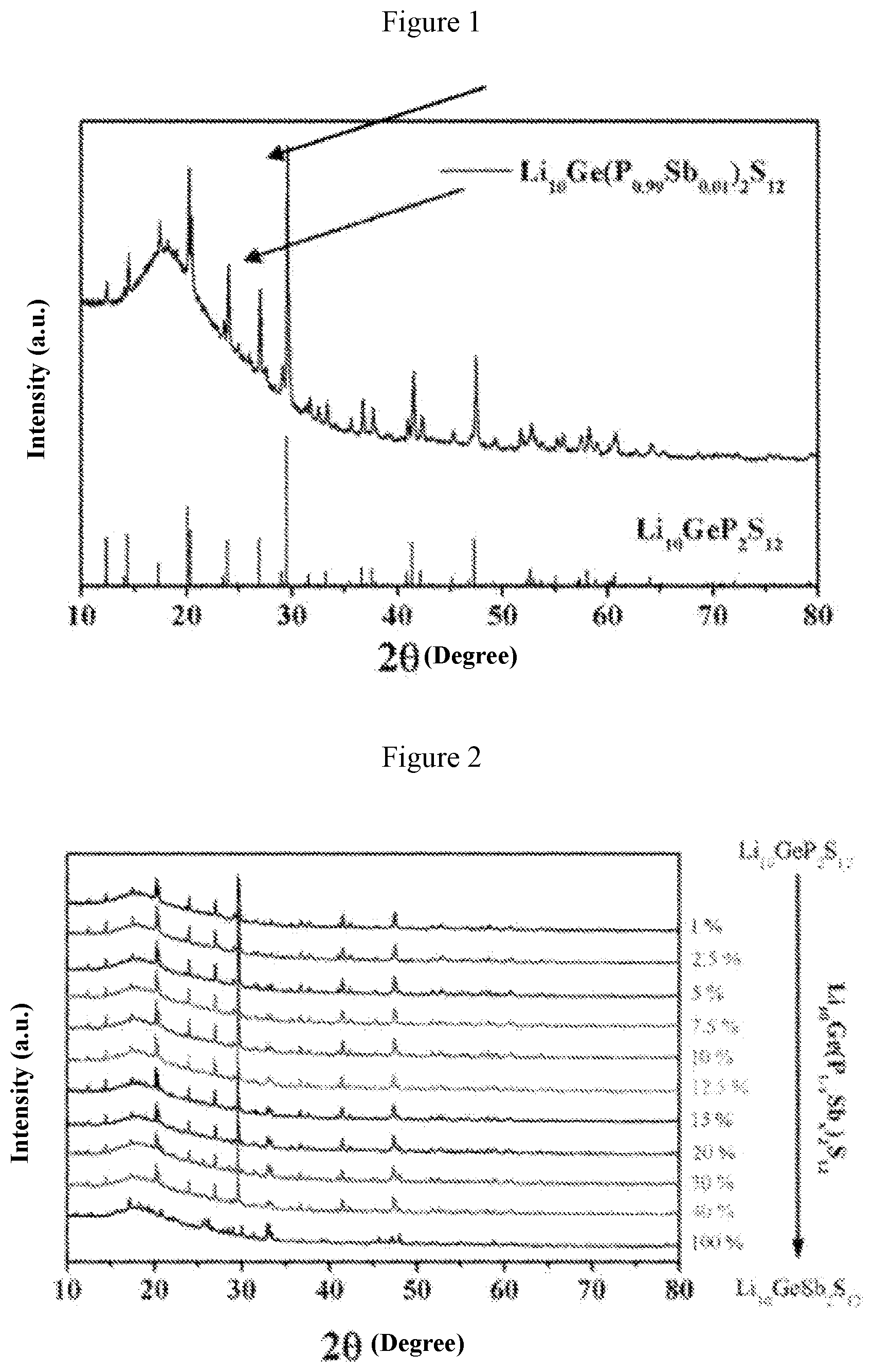
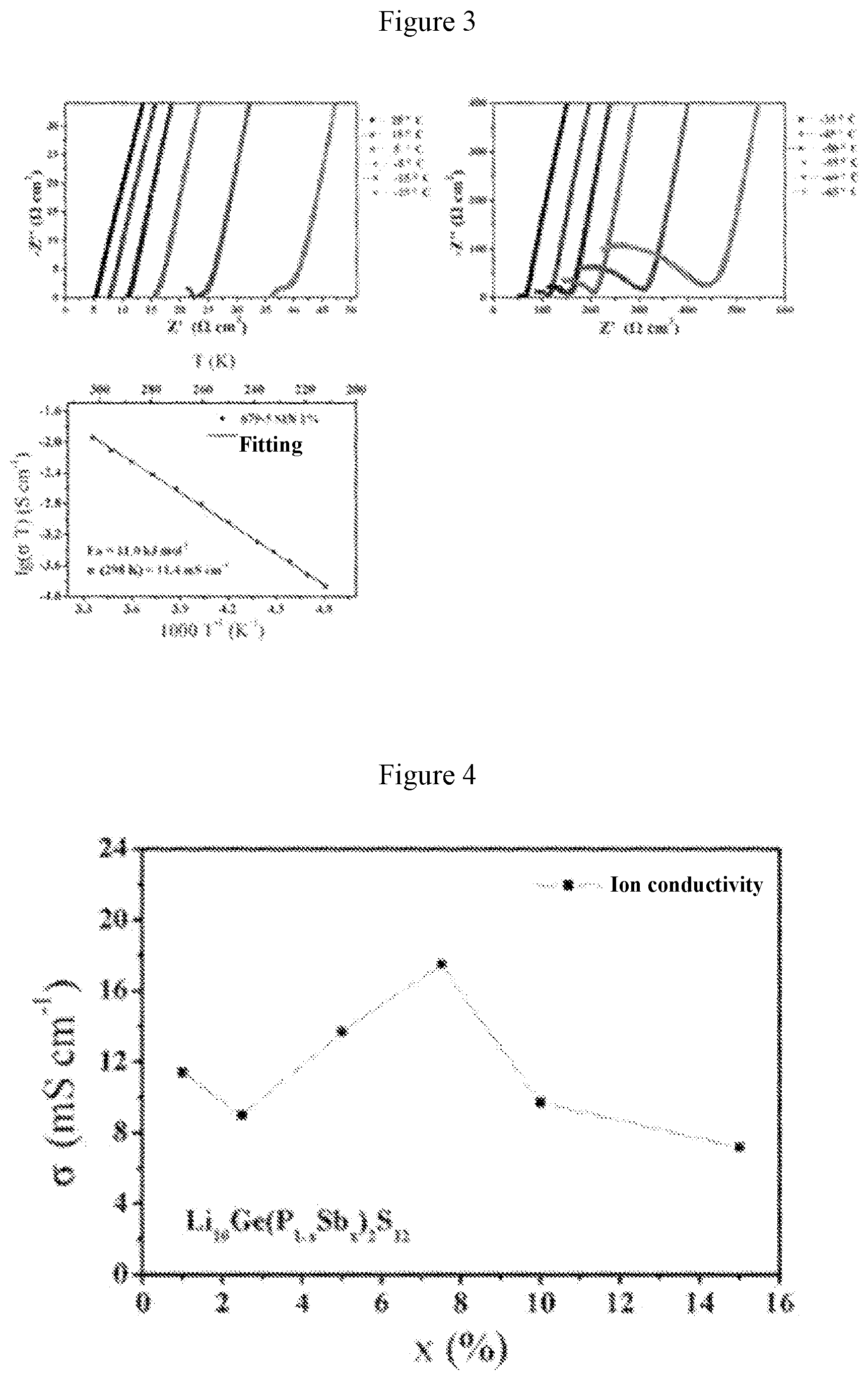
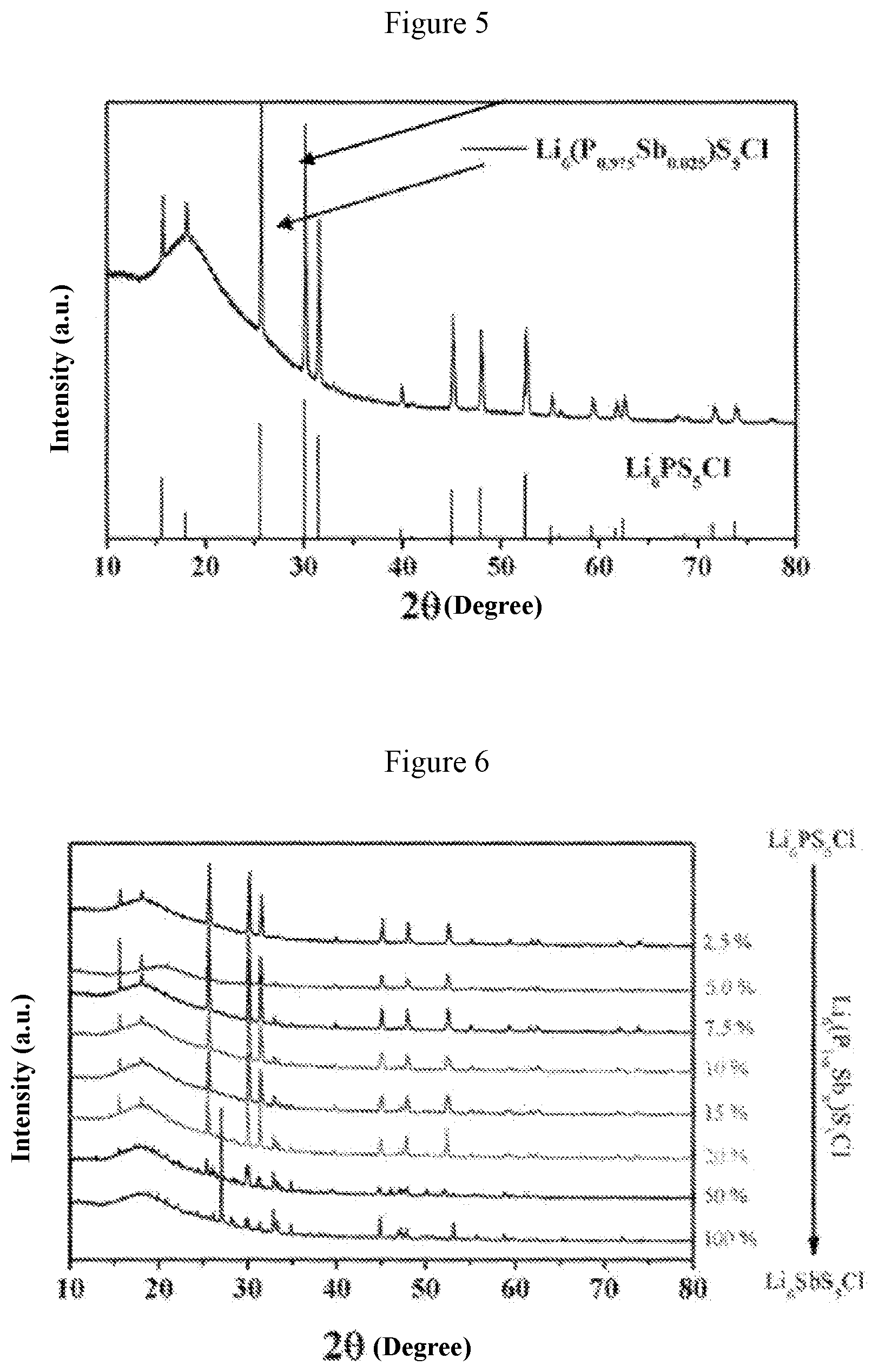
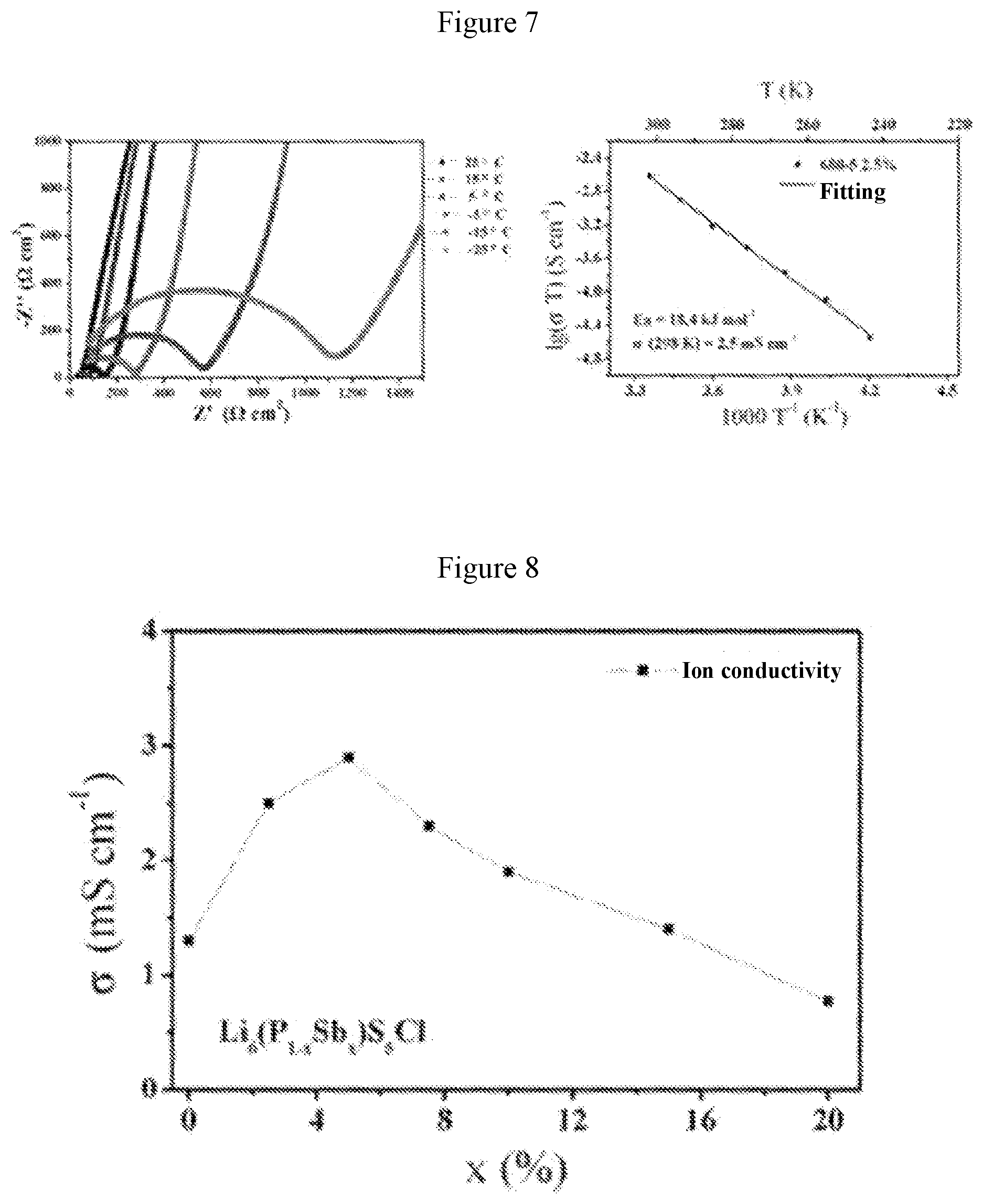
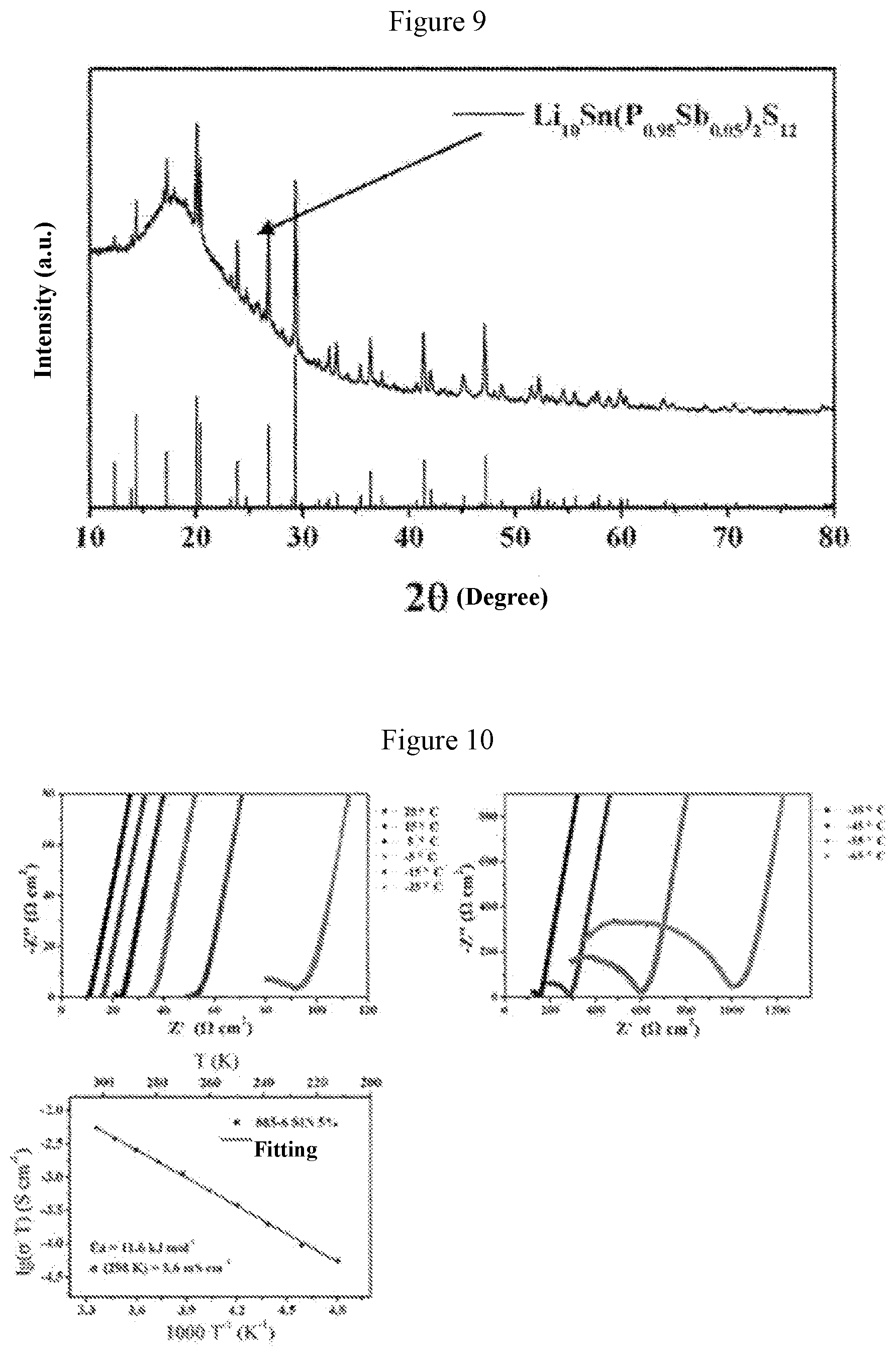
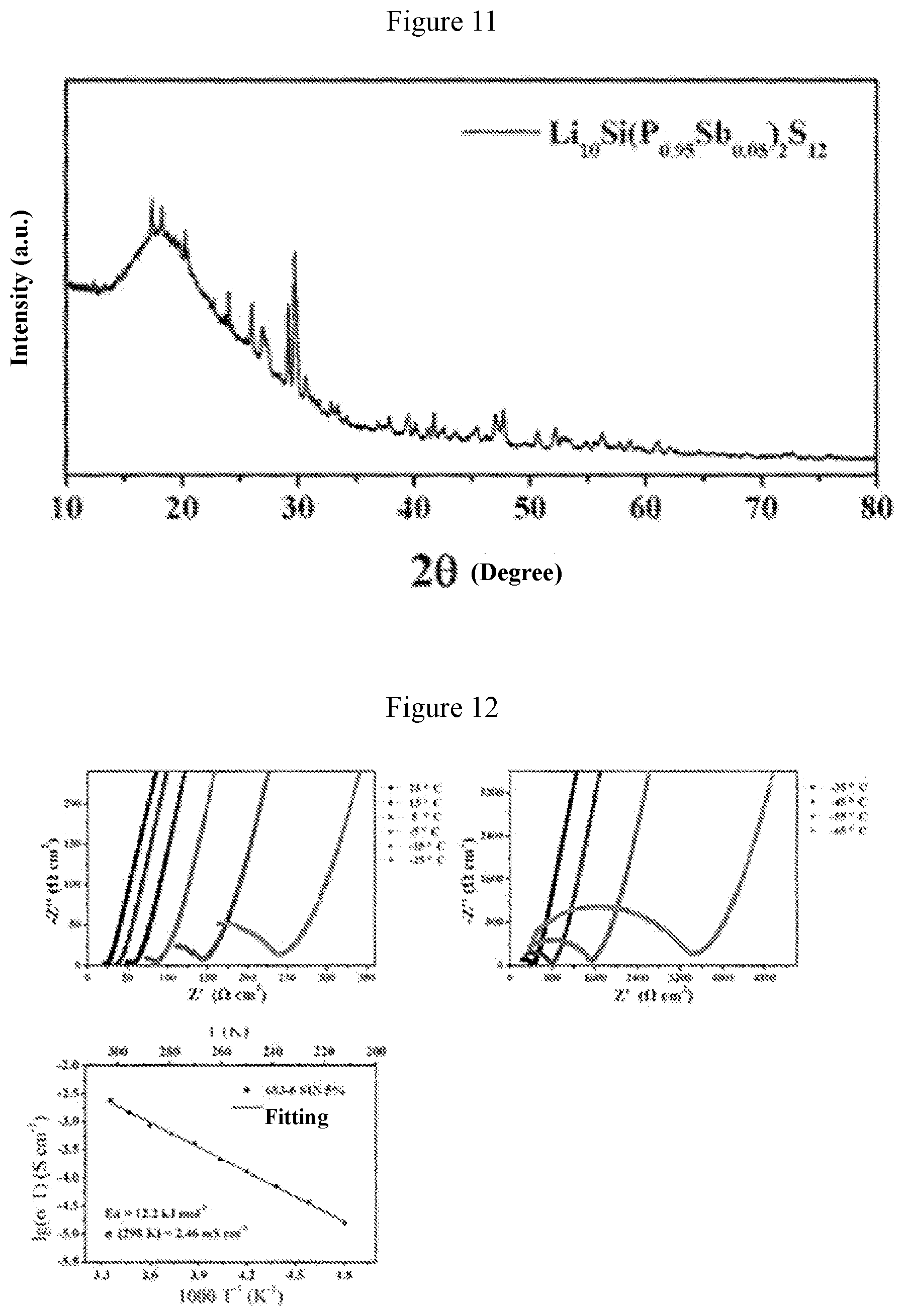
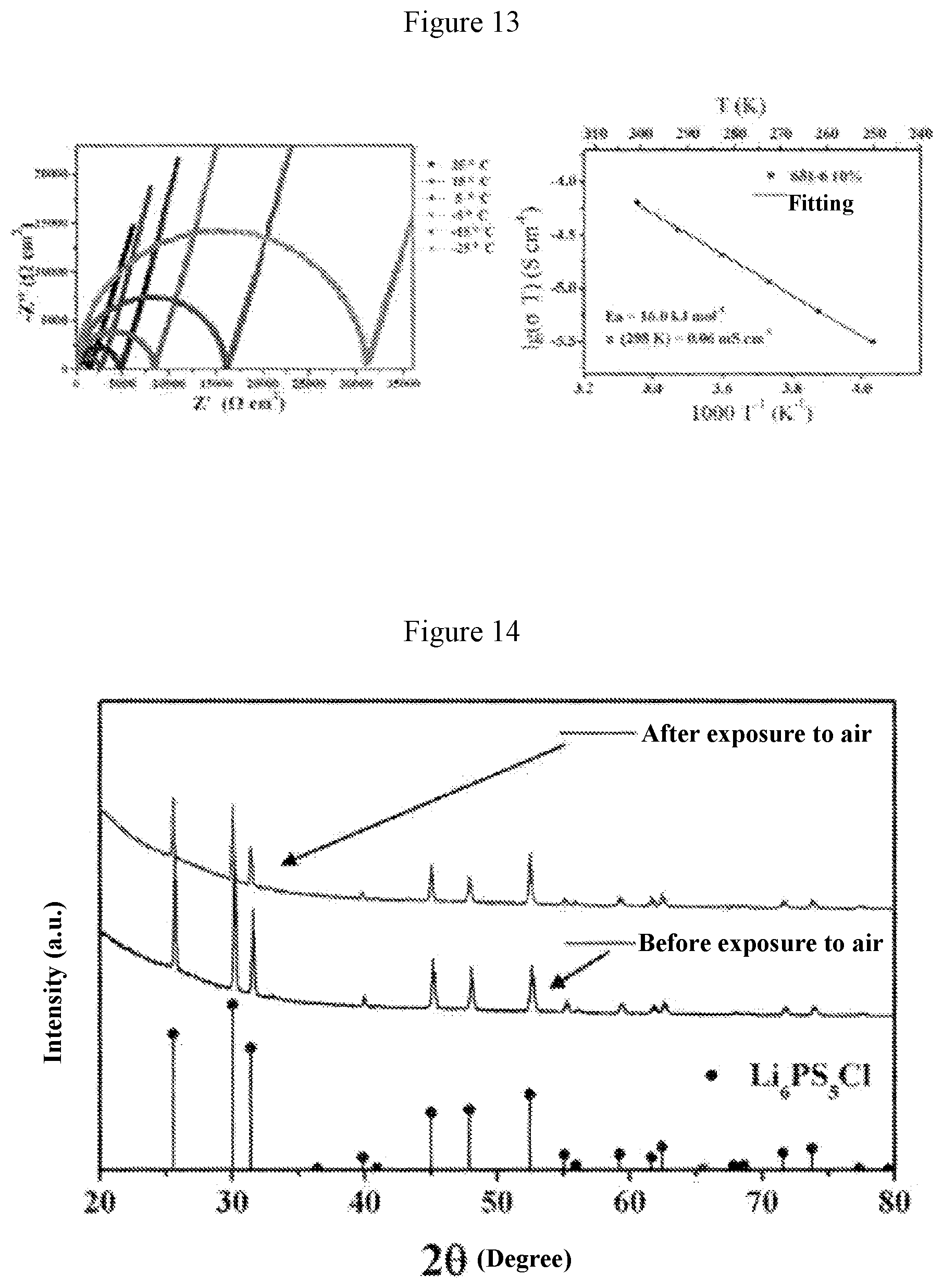
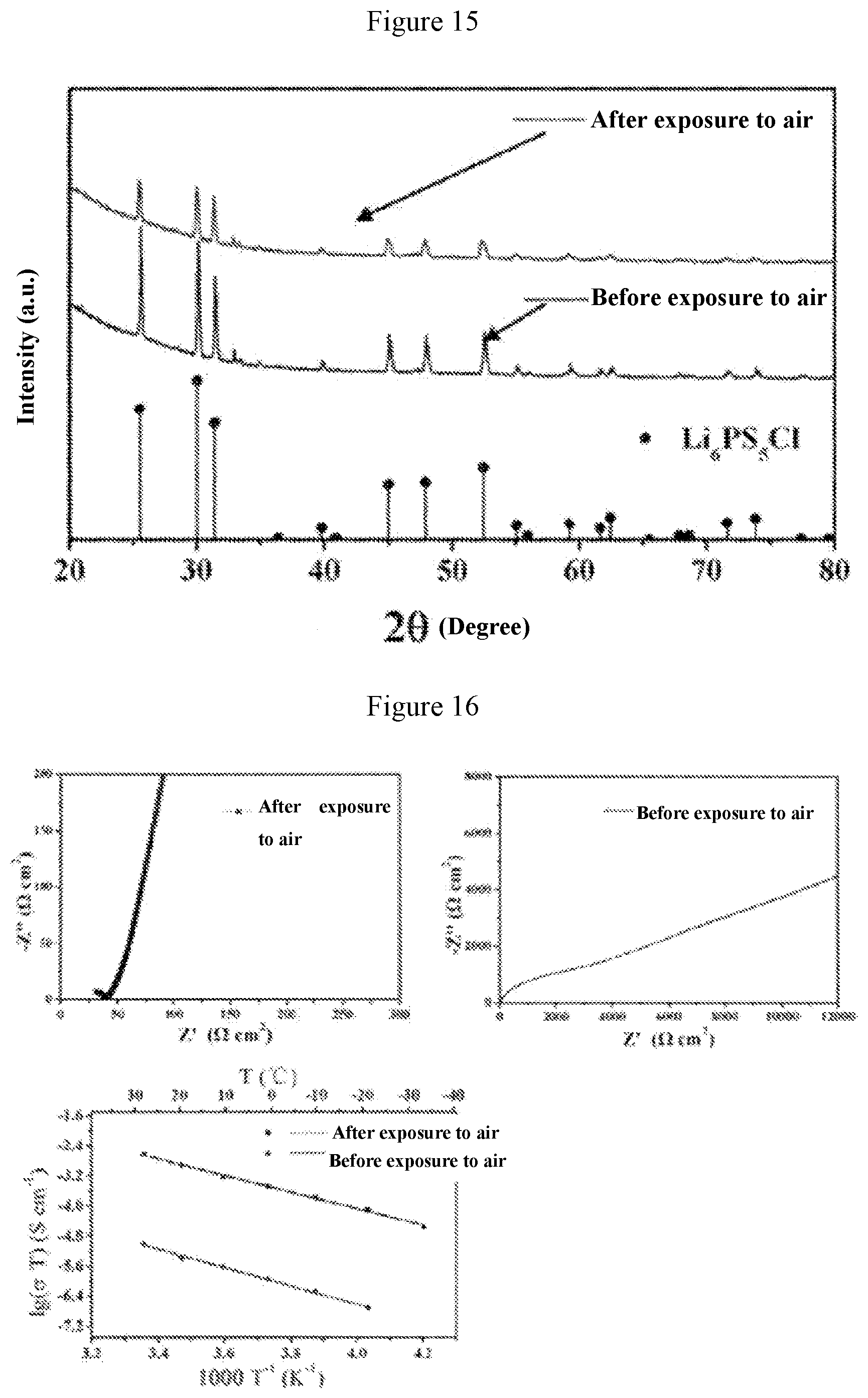


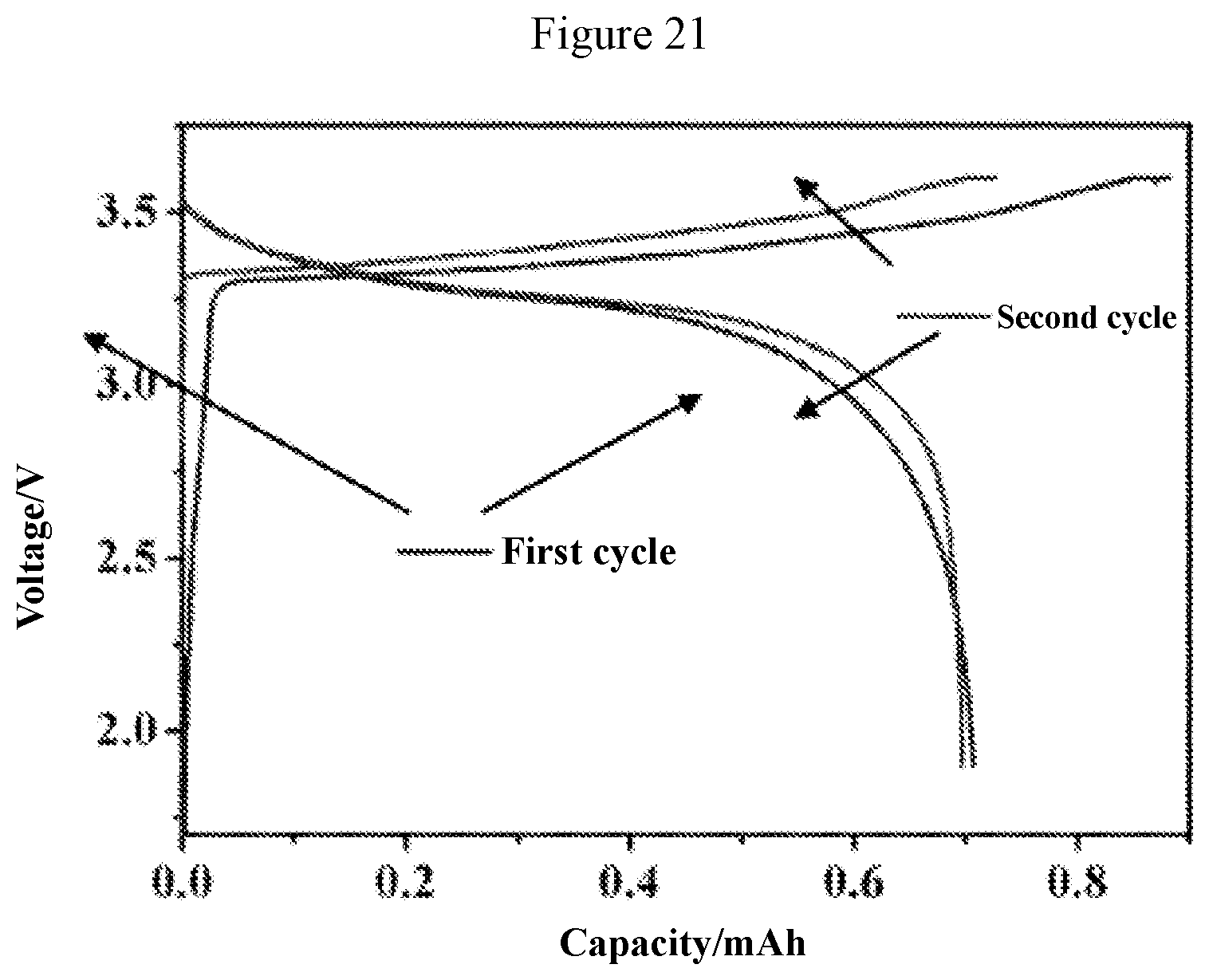
| United States Patent Application | 20220131182 |
| Kind Code | A1 |
| SUN; Xueliang ; et al. | April 28, 2022 |
INORGANIC SULFIDE SOLID ELECTROLYTE HAVING HIGH AIR STABILITY, AND PREPARATION METHOD AND USE THEREOF
Abstract
An inorganic sulfide solid electrolyte having high air stability, and a preparation method and use thereof In the invention, some or all of P elements in a sulfide electrolyte are replaced with Sb elements, thereby providing an electrolyte having high air stability and ion mobility and applicable to an all-solid lithium secondary battery. The resulting inorganic sulfide electrolyte comprises the following materials: Li.sub.10M(P.sub.1-aSb.sub.a).sub.2S.sub.12, Li.sub.6(P.sub.1-aSb.sub.a)S.sub.5X and Li.sub.3(P.sub.1-aSb.sub.a)S.sub.4, where M is one or more of Ge, Si or Sn, X is one or more of F, Cl, Br or I, and 0.01.ltoreq.a.ltoreq.1.
| Inventors: | SUN; Xueliang; (London, CA) ; LIANG; Jianwen; (London, CA) ; LI; Xiaona; (London, CA) ; HUANG; Huan; (London, CA) ; LU; Shigang; (Beijing, CN) ; ZHANG; Li; (Beijing, CN) ; ZHAO; Shangqian; (Beijing, CN) | ||||||||||
| Applicant: |
|
||||||||||
|---|---|---|---|---|---|---|---|---|---|---|---|
| Family ID: | 1000006113354 | ||||||||||
| Appl. No.: | 17/422789 | ||||||||||
| Filed: | December 6, 2019 | ||||||||||
| PCT Filed: | December 6, 2019 | ||||||||||
| PCT NO: | PCT/CN2019/123481 | ||||||||||
| 371 Date: | July 14, 2021 |
| Current U.S. Class: | 1/1 |
| Current CPC Class: | C01G 30/002 20130101; C01P 2002/72 20130101; H01M 10/0562 20130101; C01G 30/003 20130101; H01M 2300/0068 20130101; C01P 2006/40 20130101 |
| International Class: | H01M 10/0562 20100101 H01M010/0562; C01G 30/00 20060101 C01G030/00 |
Foreign Application Data
| Date | Code | Application Number |
|---|---|---|
| Apr 30, 2019 | CN | 2019103589538 |
Claims
1. An inorganic sulfide electrolyte material represented by the following formula (I), Li.sub.10M(P.sub.1-aSb.sub.a).sub.2S.sub.12, (I); wherein, M is one or more of Ge, Si and Sn, 0.01.ltoreq.a.ltoreq.1; preferably, 0.01.ltoreq.a.ltoreq.0.2.
2. The inorganic sulfide electrolyte material according to claim 1, wherein a is selected from 0.01, 0.025, 0.05, 0.075, 0.1, 0.125, 0.15, 0.2, 0.3, 0.4 or 1; preferably, the inorganic sulfide electrolyte material represented by the formula (I) is Li.sub.10Ge(P.sub.0.99Sb.sub.0.01).sub.2S.sub.12, Li.sub.10Ge(P.sub.0.975Sb.sub.0.025).sub.2S.sub.12, Li.sub.10Ge(P.sub.0.925Sb.sub.0.075).sub.2S.sub.12, Li.sub.10Ge(P.sub.0.9Sb.sub.0.1).sub.2S.sub.12, Li.sub.10Ge(P.sub.0.875Sb.sub.0.125).sub.2S.sub.12, Li.sub.10Sn(P.sub.0.95Sb.sub.0.05).sub.2S.sub.12 or Li.sub.10Si(P.sub.0.95Sb.sub.0.05).sub.2S.sub.12.
3. An inorganic sulfide electrolyte material represented by the following formula (II), Li.sub.6(P.sub.1-aSb.sub.a)S.sub.5X, (II); wherein X is one or more of F, Cl, Br and I, 0.01.ltoreq.a.ltoreq.1; preferably, 0.025.ltoreq.a.ltoreq.0.2.
4. The inorganic sulfide electrolyte material according to claim 3, wherein a is selected from 0.025, 0.05, 0.075, 0.1, 0.15, 0.2, 0.5 or 1; preferably, the inorganic sulfide electrolyte material represented by the formula (II) is Li.sub.6(P.sub.0.975Sb.sub.0.025)S.sub.5Cl or Li.sub.6(P.sub.0.95Sb.sub.0.05)S.sub.5Cl.
5. An inorganic sulfide electrolyte material represented by the following formula (III), Li.sub.3(P.sub.1-aSb.sub.a)S.sub.4, (III); wherein, 0.01.ltoreq.a.ltoreq.1; preferably, 0.05.ltoreq.a.ltoreq.0.3.
6. The inorganic sulfide electrolyte material according to claim 5, wherein a is selected from 0.05, 0.1, 0.2 or 0.3.
7. The inorganic sulfide electrolyte material according to claim 1, wherein the inorganic sulfide electrolyte material is a crystalline, amorphous or crystalline-amorphous composite type; and/or a working temperature of the sulfide solid electrolyte material is -100.degree. C. to 300.degree. C.
8. The preparation method of the inorganic sulfide electrolyte material according to claim 1, characterized by mixing the required raw materials according to the proportion, and grinding, and then performing heat treatment to obtain the sulfide electrolyte materials represented by the formula (I), formula (II), and formula (III), respectively.
9. The preparation method according to claim 8, wherein the time for the grinding is greater than 3 h; and/or the temperature for the heat treatment is greater than 300.degree. C. and less than 600.degree. C.
10. The preparation method according to claim 8, wherein the time for the grinding is greater than 3 h; and/or the temperature for the heat treatment is greater than 230.degree. C. and less than 600.degree. C.
11. A method for preparing an all-solid-state lithium secondary battery, wherein the method comprises using the sulfide solid electrolyte materials according to claim 1.
12. The inorganic sulfide electrolyte material according to claim 3, wherein the inorganic sulfide electrolyte material is a crystalline, amorphous or crystalline-amorphous composite type; and/or a working temperature of the sulfide solid electrolyte material is -100.degree. C. to 300.degree. C.
13. The inorganic sulfide electrolyte material according to claim 5, wherein the inorganic sulfide electrolyte material is a crystalline, amorphous or crystalline-amorphous composite type; and/or
14. The preparation method of the inorganic sulfide electrolyte material according to claim 3, characterized by mixing the required raw materials according to the proportion, and grinding, and then performing heat treatment to obtain the sulfide electrolyte materials represented by the formula (I), formula (II), and formula (III), respectively.
15. The preparation method of the inorganic sulfide electrolyte material according to claim 5, characterized by mixing the required raw materials according to the proportion, and grinding, and then performing heat treatment to obtain the sulfide electrolyte materials represented by the formula (I), formula (II), and formula (III), respectively.
16. A method for preparing an all-solid-state lithium secondary battery, wherein the method comprises using the sulfide solid electrolyte materials according to claim 3.
17. A method for preparing an all-solid-state lithium secondary battery, wherein the method comprises using the sulfide solid electrolyte materials according to claim 5.
18. A method for preparing an all-solid-state lithium secondary battery, wherein the method comprises using the sulfide solid electrolyte materials prepared by the method according to claim 8.
Description
CROSS REFERENCE TO RELATED APPLICATION
[0001] The present application claims the priority to the Chinese patent application No. 201910358953.8 entitled "Inorganic sulfide solid electrolyte having high air stability, and preparation method and use thereof" filed on Apr. 30, 2019, the disclosure of which is incorporated by reference in its entirety.
TECHNICAL FIELD
[0002] The present invention belongs to the technical field of lithium-ion batteries, and specifically relates to a method for improving the air stability of an inorganic sulfide solid electrolyte, the obtained material and use thereof in an all-solid-state lithium secondary battery.
BACKGROUND ART
[0003] Lithium ion secondary batteries have developed rapidly due to their advantages such as high energy density and long service life since its commercialization in the early 1990s. However, currently lithium-ion batteries used commonly are liquid-state batteries, which contain flammable organic electrolyte solutions and thus have serious potential safety hazards. In recent years, the frequent occurrence of safety accidents on liquid lithium-ion power batteries has greatly restricted the further use of this system. The non-flammable inorganic solid materials used as the electrolytes of lithium-ion batteries can not only eliminate the potential safety hazards caused by the leakage of organic electrolyte solutions and thermal runaway inside the batteries during the use of batteries, but also enable batteries to be used under extreme conditions such as high temperature and low temperature, which further improves the value of lithium secondary batteries and extends the application fields thereof. Therefore, the development of an inorganic solid electrolyte with high stability and high lithium-ion conductivity is a key for the development of a lithium secondary battery with high safety.
[0004] Among the electrolyte varieties classified based on the type of the negative ions in the inorganic solid electrolyte materials, oxide solid electrolytes have been much more studied and sulfide solid electrolytes have better potential of application (Kerman K, Luntz A, Viswanathan V, et al. practical challenges hindering the development of solid state Li ion batteries [J]. Journal of The Electrochemical Society, 2017, 164 (7): A1731-A1744.). The oxide solid electrolyte is mainly based on the systems such as Li.sub.2O--LaO--ZrO.sub.2, Li.sub.2O--B.sub.2O.sub.3, and Li.sub.2O--LiCl (Thangadurai V, Narayanan S, Pinzaru D. Garnet-type solid-state fast Li ion conductors for Li batteries: critical review [J]. Chemical Society Reviews, 2014, 43 (13): 4714-4727), but generally provided with low the ion conductance. Compared with oxide electrolytes, sulfide electrolytes show higher ion conductance, because the binding force thereof to cations is lower due to the low electronegativity of sulfide ions, and the radius of the sulfide ion is larger, which is beneficial to the migration of lithium ions. For example, the lithium ion conductivity of the following materials is higher than that of organic electrolytes: Li.sub.10GeP.sub.2S.sub.12 material discovered in 2010 (the ion conductivity is as high as 12 mS cm.sup.-1 at room temperature, Kamaya N, Homma K, Yamakawa Y, et al. A lithium superionic conductor [J]. Nature materials, 2011, 10 (9): 682) and Li.sub.9.54Si.sub.1.74P.sub.1.44S.sub.11.7Cl.sub.0.3 material discovered in 2015 (the ion conductivity is as high as 25 mS cm.sup.-1 at room temperature, Kato Y, Hori S, Saito T et al. High-power all-solid-state batteries using sulfide superionic conductors [J]. Nature Energy, 2016, 1 (4): 16030). At present, the research on inorganic sulfide electrolytes mainly focuses on the systems such as Li.sub.2S--P.sub.2S.sub.5, Li.sub.2S--MS.sub.x--P.sub.2S.sub.5 and Li.sub.2S--P.sub.2S.sub.5-LiX (Sun C, Liu J, Gong Y, et al. Recent advances in all-solid-state rechargeable lithium batteries [J]. Nano Energy, 2017, 33: 363-386).
[0005] However, the currently reported inorganic sulfide electrolytes containing P element are not stable under air conditions. This type of sulfide electrolyte reacts irreversibly with oxygen gas, water vapor, carbon dioxide and the like in the air atmosphere, resulting in structural changes and a decrease in ion conductivity, which severely restricts its application in all-solid-state lithium batteries. In response to this problem, a lot of research has focused on the improvement through the introduction of additives and surface protective layers. For example, a composite solid electrolyte material uses a sulfide electrolyte material as the inner layer, and a protective layer of lithium borate and the like as the outer shell (Yang Rong et al., Chinese Patent CN106887638A). In addition, the thermal/air stability of the material can be improved by doping a small amount of low-valence metal elements or a small amount of oxide LMO (M=Si, P, Ge, B, Al, Ga, In) into the sulfide electrolyte system (Xu Xiaoxiong, Qiu Zhijun, Huang Zhen, Chen Wanchao, Chen Xiaotian, Chinese Patent CN10353184A; and Bachman J C, Muy S, Grimaud A, et al. Inorganic solid-state electrolytes for lithium batteries: mechanisms and properties governing ion conduction [J]. Chemical reviews, 2015, 116 (1): 140-162.). Theoretically, the ion conductivity of the materials can be regulated by adjusting the factors such as lithium ion migration channel and the binding force of sulfide ions to cations in the sulfide electrolyte material by means of the structure of the solid solution phase, so as to obtain inorganic sulfide electrolytes with higher ion conductivity. Furthermore, its electronic structure can also be changed by means of the structure of the solid solution phase to improve its chemical properties, so as to achieve better stability in the air, and realize the possibility of extensive use in an air environment/drying chamber.
SUMMARY OF THE INVENTION
[0006] The purpose of the present invention is to provide a method for improving the air stability of the inorganic sulfide electrolyte and the use of the material obtained by the method in an all-solid-state lithium secondary battery. The method is simple and efficient, and the obtained material is simple to prepare, and has low production cost, good air stability, and high lithium ion conductivity, and it is expected to solve the actual application problem of the inorganic sulfide electrolyte as the electrolyte of a high-performance all-solid-state lithium secondary battery.
[0007] By the research of the present invention, it was found that an inorganic sulfide solid electrolyte material with a solid solution phase structure can be formed by replacing some or all of P elements in a sulfide electrolyte with Sb, thereby obtaining higher air stability and higher ion mobility. In particular, as the amount of Sb substitution in the inorganic sulfide solid electrolyte increases, the obtained material has better air stability and can be used in all-solid-state lithium secondary batteries.
[0008] Specifically, the present invention provides an inorganic sulfide electrolyte material represented by the following formula (I),
Li.sub.10M(P.sub.1-aSb.sub.a).sub.2S.sub.12, (I);
[0009] wherein, M is one or more of Ge, Si and Sn, 0.01.ltoreq.a.ltoreq.1; preferably, 0.01.ltoreq.a.ltoreq.0.2. For example, specifically, a may be selected from 0.01, 0.025, 0.05, 0.075, 0.1, 0.125, 0.15, 0.2, 0.3, 0.4 or 1.
[0010] Specifically, the inorganic sulfide electrolyte material represented by the formula (I) is Li.sub.10Ge(P.sub.0.99Sb.sub.0.01).sub.2S.sub.12, Li.sub.10Ge(P.sub.0.975Sb.sub.0.025).sub.2S.sub.12, Li.sub.10Ge(P.sub.0.925 Sb.sub.0.075).sub.2S.sub.12, Li.sub.10Ge(P.sub.0.9Sb.sub.0.1).sub.2S.sub.12, Li.sub.10Ge(P.sub.0.875Sb.sub.0.125).sub.2S.sub.12, Li.sub.10Sn(P.sub.0.95Sb.sub.0.05).sub.2S.sub.12 or Li.sub.10Si(P.sub.0.95 Sb.sub.0.05).sub.2S.sub.12.
[0011] The present invention also provides an inorganic sulfide electrolyte material represented by the following formula (II),
Li.sub.6(P.sub.1-aSb.sub.a)S.sub.5X, (II);
[0012] wherein, X is one or more of F, Cl, Br, and I, 0.01.ltoreq.a.ltoreq.1; preferably, 0.025.ltoreq.a.ltoreq.0.2. For example, specifically, a may be selected from 0.025, 0.05, 0.075, 0.1, 0.15, 0.2, 0.5 or 1.
[0013] Specifically, the inorganic sulfide electrolyte material represented by the formula (II) is Li.sub.6(P.sub.0.975Sb.sub.0.025)S.sub.5Cl or Li.sub.6(P.sub.0.95Sb.sub.0.05)S.sub.5Cl.
[0014] The present invention also provides an inorganic sulfide electrolyte material represented by the following formula (III),
Li.sub.3(P.sub.1-aSb.sub.a)S.sub.4, (III);
[0015] wherein, 0.01.ltoreq.a.ltoreq.1; preferably, 0.05.ltoreq.a.ltoreq.0.3. Further preferably, a is selected from 0.05, 0.1, 0.2 or 0.3.
[0016] The above-mentioned inorganic sulfide electrolyte materials of the present invention can be prepared according to conventional techniques in the art.
[0017] For example, the required raw materials can be mixed according to the proportion, and ground, and then subjected to heat treatment to obtain the sulfide electrolyte materials represented by the formula (I), formula (II) and formula (III), wherein the time for the grinding is preferably greater than 3 h, and/or the temperature for the heat treatment is preferably greater than 300.degree. C. and less than 600.degree. C.; and/or the temperature for the heat treatment is preferably greater than 230.degree. C. and less than 600.degree. C. The present invention is a solid solution phase type sulfide solid electrolyte material.
[0018] By further research, it was found that, for any of the above-mentioned sulfide solid electrolyte materials, as the amount of Sb in the solid solution phase increases, the obtained inorganic sulfide solid electrolyte material has higher air stability. Furthermore, the lithium ion conductivity of the material can be further adjusted by adjusting the ratio of P and Sb elements in the solid solution, and the electroconductivity thereof can exceed those of other existing solid electrolytes and organic liquid electrolytes.
[0019] Further, any one of the above-mentioned sulfide solid electrolyte materials is of crystalline type, amorphous type, or crystalline-amorphous composite type.
[0020] Further, a working temperature of any one of the above-mentioned sulfide solid electrolyte materials is -100.degree. C. to 300.degree. C.
[0021] The present invention also provides the use of any one of the above-mentioned sulfide solid electrolyte materials in the preparation of an all-solid-state lithium secondary battery.
[0022] Specifically, the present invention provides an all-solid-state lithium secondary battery, comprising a positive electrode, an electrolyte material, and a negative electrode, wherein the electrolyte material is the sulfide electrolyte material described in the above technical solutions or the sulfide electrolyte material prepared by the above technical solutions.
[0023] The present invention uses Sb to replace some or all of the P elements in the sulfide electrolyte to form an inorganic sulfide solid electrolyte material with a solid solution phase structure, thereby achieving higher air stability and higher ion mobility. Compared with the prior art, the present invention provides a novel method for improving the air stability of sulfide by element substitution. The method is simple and efficient. The obtained sulfide electrolyte can be stably stored under air conditions without any protection of claddings or additives. This type of material is simple to prepare and has low production cost, and meanwhile, the obtained inorganic sulfide solid electrolyte material has controllable ion conductivity and shows excellent performance as an inorganic electrolyte and electrode material additive in an all-solid-state lithium battery.
[0024] The present invention has the following advantages:
[0025] 1) Sulfide solid electrolytes having a variety of different types of solid solution phase structures are obtained by adjusting the proportion of P and Sb in the inorganic sulfide solid electrolyte materials. With the increase of the amount of Sb substitution, the obtained inorganic sulfide solid electrolyte material has higher air stability, and thus the present invention can further realize the use of the sulfide solid electrolyte material in the drying chamber, simplify the production process of solid-state batteries and reduce production costs.
[0026] 2) In the sulfide solid electrolyte with a solid solution phase structure, the chemical properties of the material can be adjusted by replacing some of P elements with Sb elements, thereby obtaining high chemical stability and chemical compatibility with the electrode material, and reducing the reaction activity of the electrolyte with lithium metal and common positive and negative materials for lithium ion batteries.
[0027] 3) The crystal structure and electronic structure of the material can be easily regulated by adjusting the ratio of P and Sb in the inorganic sulfide solid electrolyte material, thereby further improving the electroconductivity of the material. Among the inorganic sulfide solid electrolyte materials with this type of solid solution phase structure, a part of the electrolyte materials reach or even exceed the electroconductivity of the existing sulfide solid electrolytes.
[0028] 4) The proposal and acquisition of the sulfide solid electrolyte with a solid solution phase structure help to further understand the issue of chemical stability of the electrolyte and the issue of migration of lithium ions in the solid electrolyte in terms of theoretical research, and further guide the development and research of sulfide electrolytes with high electroconductivity. In practical application, many different types of electrolyte materials with high conductivity and high air stability can be obtained.
BRIEF DESCRIPTION OF THE DRAWINGS
[0029] FIG. 1 is an x-ray diffraction pattern obtained when a=0.01 in Example 1;
[0030] FIG. 2 shows some x-ray diffraction patterns obtained from the system in Example 1;
[0031] FIG. 3 shows graphs of electrochemical impedance and ion conductivity at different temperatures obtained when a=0.01 in Example 1;
[0032] FIG. 4 is a graph showing the relationship between the ion conductivity and the value of "a" of the material obtained in Example 1;
[0033] FIG. 5 is an x-ray diffraction pattern obtained when a=0.025 in Example 2;
[0034] FIG. 6 shows some x-ray diffraction patterns obtained from the system in Example 2;
[0035] FIG. 7 shows graphs of electrochemical impedance and ion conductivity at different temperatures obtained when a=0.025 in Example 2;
[0036] FIG. 8 is a graph of the relationship between the ion conductivity and the value of "a" of the material obtained in Example 2;
[0037] FIG. 9 is an x-ray diffraction pattern obtained when a=0.05 in Example 3;
[0038] FIG. 10 shows graphs of electrochemical impedance and ion conductivity at different temperatures obtained when a=0.05 in Example 3;
[0039] FIG. 11 is an x-ray diffraction pattern obtained when a=0.05 in Example 4;
[0040] FIG. 12 shows graphs of electrochemical impedance and ion conductivity at different temperatures obtained when a=0.05 in Example 4;
[0041] FIG. 13 shows graphs of electrochemical impedance and ion conductivity at different temperatures obtained when a=0.1 in Example 5;
[0042] FIG. 14 shows comparison of XRD patterns of the Li.sub.6(P.sub.0.975Sb.sub.0.025)S.sub.5Cl material before and after exposure to air in Application Example 1;
[0043] FIG. 15 shows comparison of XRD patterns of the Li.sub.6(P.sub.0.9Sb.sub.0.1)S.sub.5Cl material before and after exposure to air in Application Example 1;
[0044] FIG. 16 shows graphs concerning comparison of the electrochemical impedance spectroscopies and comparison of ion conductivities (obtained by calculation) of the Li.sub.6(P.sub.0.975Sb.sub.0.025)S.sub.5Cl material before and after exposure to air in Application Example 1;
[0045] FIG. 17 shows graphs concerning comparison of the electrochemical impedance spectroscopies and comparison of the ion conductivities (obtained by calculation) of the Li.sub.6(P.sub.0.9Sb.sub.0.1)S.sub.5Cl material before and after exposure to air in Application Example 1;
[0046] FIG. 18 shows graphs of the ion conductivity varying with change in temperature and current-time relationship graphs at a constant external voltage of 0.3 V for the Li.sub.6(P.sub.0.975Sb.sub.0.025)S.sub.5Cl and Li.sub.6(P.sub.0.9Sb.sub.0.1)S.sub.5Cl in Application Example 1;
[0047] FIG. 19 shows comparison of XRD patterns of the Li.sub.10Ge(P.sub.0.875Sb.sub.0.125).sub.2S.sub.12 material before and after exposure to air in Application Example 2;
[0048] FIG. 20 shows comparison graphs of ion conductivities of the solid electrolyte materials of Li.sub.10Ge(P.sub.0.75Sb.sub.0.025).sub.2S.sub.12, Li.sub.10Ge(P.sub.0.925Sb.sub.0.075).sub.2S.sub.12, Li.sub.1Ge(P.sub.0.9Sb.sub.0.1).sub.2S.sub.12 and Li.sub.10Ge(P.sub.0.875Sb.sub.0.125).sub.2S.sub.12 before and after exposure to air in Application Example 2.
[0049] FIG. 21 is a graph showing the charging and discharging curve of an all-solid-state Li--LiCoO.sub.2 secondary battery using the solid solution phase type Li.sub.10Ge(P.sub.0.99Sb.sub.0.01).sub.2S.sub.12 solid electrolyte material obtained in Application Example 3.
SPECIFIC MODES FOR CARRYING OUT THE EMBODIMENTS
[0050] The following Examples are used to illustrate the present invention, but are not used to limit the scope of the present invention. If the specific technologies or conditions are not indicated in the Examples, the Examples shall be carried out according to those described in the literatures in the field, or according to the product specification. If the manufacturers for some reagents or instruments are not indicated, the reagents or instruments used are conventional products that can be purchased through regular channels.
EXAMPLE 1: PREPARATION OF THE SOLID ELECTROLYTE MATERIAL Li.sub.10Ge(P.sub.1-aSb.sub.a).sub.2S.sub.12 (0.01.ltoreq.a.ltoreq.1)
[0051] 15 mmoles of Li.sub.2S (0.69 g), 3 mmoles of GeS.sub.2 (0.411 g), (3-3a) mmoles of P.sub.2S.sub.5, and 3a mmoles of Sb.sub.2S.sub.5 powder were ground and mixed in a mortar, wherein 0.01.ltoreq.a.ltoreq.1. For example, if a=0.01, the formulation of various raw material was as follows: Li.sub.2S.sub.0.69 g, GeS.sub.2 0.411 g, P.sub.2S.sub.5 0.66 g, and Sb.sub.2S.sub.5 0.012 g. If a=0.1, the formulation of various raw material was as follows: Li.sub.2S 0.69 g, GeS.sub.2 0.411 g, P.sub.2S.sub.5 0.599 g, and Sb.sub.2S.sub.5 0.121 g, and so on. After being ground and mixed, the mixture was put into a 50 ml zirconia ball mill tank for ball milling at a ball milling speed of 400 revolutions per minute for 12 h. After being ball milled, the samples were compressed into round tablets at 100 MPa using a powder tableting machine, and then sealed in a vacuum quartz tube for calcination. The calcination temperature was controlled by programmed temperature rise. The temperature was increased from room temperature to 550.degree. C. in 4 h, maintained at 550.degree. C. for 4 h, and then controlled to decrease to 50.degree. C. in 4 h, to obtain Li.sub.10Ge(P.sub.1-aSb.sub.a).sub.2S.sub.12 solid electrolyte material (0.01.ltoreq.a.ltoreq.1).
[0052] FIG. 1 shows the X-ray diffraction patterns of the material when a=0.01 (i.e., the solid electrolyte material Li.sub.10Ge(P.sub.0.99Sb.sub.0.01).sub.2S.sub.12) and Li.sub.10GeP.sub.2S.sub.12 standard card (JPCDF: 04-020-5216). FIG. 2 shows the X-ray diffraction patterns for the system with different values of a, wherein a is 0.01, 0.025, 0.05, 0.075, 0.1, 0.125, 0.15, 0.2, 0.3, 0.4 and 1 from top to bottom, respectively. FIG. 3 shows graphs of electrochemical impedance at different temperatures and curve of ion conductivity varying with temperature for the material when a=0.01 (i.e., the solid electrolyte material Li.sub.10Ge(P.sub.0.99Sb.sub.0.01).sub.2S.sub.12). It can be obtained from FIG. 3 that the ion conductivity of this material is 11.4 millisiemens per centimeter at 25.degree. C., and the activation energy is 11.0 kJ per mole. FIG. 4 is a graph showing the relationship between the ion conductivity and the value of "a" of the solid solution phase sulfide electrolyte material obtained in this system. It is found from FIG. 4 that when the value of "a" is 0.075 (i.e., the solid electrolyte material Li.sub.10Ge(P.sub.0.925Sb.sub.0.075).sub.2S.sub.12), the material has the highest room-temperature ion conductivity of 17.5 millisiemens per centimeter, which is higher than the room-temperature ion conductivity (12 millisiemens per centimeter) of Li.sub.10GeP.sub.2S.sub.12 material reported in literatures.
EXAMPLE 2: PREPARATION OF THE SOLID ELECTROLYTE MATERIAL Li.sub.6(P.sub.1-aSb.sub.a)S.sub.5Cl (0.01.ltoreq.a.ltoreq.1)
[0053] 20 mmoles of Li.sub.2S (0.92 g), 8 mmoles of LiCl (0.336 g), (4-4a) mmoles of P.sub.2S.sub.5 and 4a mmoles of Sb.sub.2S.sub.5 powder were ground and mixed in a mortar, wherein 0.01.ltoreq.a.ltoreq.1. For example, if a=0.025, the formulation of various raw material was as follows: Li.sub.2S 0.92 g, LiCl 0.336 g, P.sub.2S.sub.5 0.866 g, and Sb.sub.2S.sub.5 0.03 g. If a=0.1, the formulation of various raw material was as follows: Li.sub.2S 0.92 g, LiCl 0.336 g, P.sub.2S.sub.5 0.799 g, and Sb.sub.2S.sub.5 0.121 g, and so on. After being ground and mixed, the mixture was put into a 50 ml zirconia ball mill tank for ball milling at a ball milling speed of 400 revolutions per minute for 12 h. After being ball milled, the samples were compressed into round tablets at 100 MPa using a powder tableting machine, and then sealed in a vacuum quartz tube for calcination. The calcination temperature was controlled by programmed temperature rise. The temperature was increased from room temperature to 550.degree. C. in 4 h, maintained at 550.degree. C. for 5 h, and then decreased to 50.degree. C. by natural cooling to obtain the solid electrolyte material Li.sub.6(P.sub.1-aSb.sub.a)S.sub.5Cl (0.01.ltoreq.a.ltoreq.1).
[0054] FIG. 5 shows the X-ray diffraction patterns of the material when a=0.025 (i.e., the solid electrolyte material Li.sub.6(P.sub.0.975Sb.sub.0.025)S.sub.5Cl) and Li.sub.6PS.sub.5Cl standard card (JPCDF: 04-018-1429). FIG. 6 shows the X-ray diffraction patterns for the system with different values of "a", wherein a is 0.025, 0.05, 0.075, 0.1, 0.15, 0.2, 0.5 and 1 from top to bottom, respectively. FIG. 7 shows graphs of electrochemical impedance at different temperatures and curve of ion conductivity varying with temperature for the material when a=0.025 (i.e., the solid electrolyte material Li.sub.6(P.sub.0.975Sb.sub.0.025)S.sub.5Cl). It can be obtained from FIG. 7 that the ion conductivity of this material is 2.5 millisiemens per centimeter at 25.degree. C., and the activation energy is 18.4 kJ per mole. FIG. 8 is a graph showing the relationship between the ion conductivity and the "a" value of the solid solution phase sulfide electrolyte material obtained in this system. It is found from FIG. 8 that when the value of a is 0.05 (i.e., the solid electrolyte material Li.sub.6(P.sub.0.95Sb.sub.0.05)S.sub.5Cl), the material has the highest room-temperature ion conductivity, i.e., 2.9 millisiemens per centimeter, which is higher than the room-temperature ion conductivity (1.3 millisiemens per cm) of the non-solid solution phase Li.sub.6PS.sub.5Cl material under the same conditions.
EXAMPLE 3: PREPARATION OF THE SOLID ELECTROLYTE MATERIAL Li.sub.10Sn(P.sub.0.95SSb.sub.0.05.sub.2S.sub.12
[0055] 15 mmoles of Li.sub.2S (0.69 g), 3 mmoles of SnS.sub.2 (0.549 g), 2.85 mmoles of P2S5 (0.633 g), and 0.15 mmoles of Sb.sub.2S.sub.5 powder (0.061 g) were ground and mixed in a mortar. After being ground and mixed, the mixture was put into a 50 ml zirconia ball mill tank for ball milling at a ball milling speed of 400 revolutions per minute for 12 h. After being ball milled, the samples were compressed into round tablets at 100 MPa using a powder tableting machine, and then sealed in a vacuum quartz tube for calcination. The calcination temperature was controlled by programmed temperature rise. The temperature was increased from room temperature to 550.degree. C. in 4 h, maintained at 550.degree. C. for 4 h, and then controlled to decrease to 50.degree. C. in 4 h to obtain the solid electrolyte material Li.sub.10Sn(P.sub.0.95Sb.sub.0.05).sub.2S.sub.12.
[0056] FIG. 9 shows the X-ray diffraction pattern of the solid electrolyte material Li.sub.10Sn(P.sub.0.95Sb.sub.0.05).sub.2S.sub.12. FIG. 10 shows graphs of electrochemical impedance at different temperatures and curve of ion conductivity varying with temperature for this solid electrolyte material. It can be obtained from FIG. 10 that the ion conductivity of this material is 5.6 millisiemens per centimeter at 25.degree. C., and the activation energy is 11.6 kJ per mole. It is found from FIG. 10 that the Li.sub.10Sn(P.sub.0.95Sb.sub.0.05).sub.2S.sub.12 solid electrolyte material has a relatively high room-temperature ion conductivity, which is closer to the room-temperature ion conductivity (6.3 millisiemens per centimeter) of the Li.sub.10SnP.sub.2S.sub.12 material reported in literatures.
EXAMPLE 4: PREPARATION OF THE SOLID ELECTROLYTE MATERIAL Li.sub.10Si(P.sub.0.95Sb.sub.0.05).sub.2S.sub.12
[0057] 15 mmoles of Li.sub.2S (0.69 g), 3 mmoles of SiS.sub.2 (0.276 g), 2.85 mmoles of P.sub.2S.sub.5 (0.633 g), and 0.15 mmoles of Sb.sub.2S.sub.5 powder (0.061 g) were ground and mixed in a mortar. After being ground and mixed, the mixture was put into a 50 ml zirconia ball mill tank for ball milling at a ball milling speed of 400 revolutions per minute for 12 h. After being ball milled, the samples were compressed into round tablets at 100 MPa using a powder tableting machine, and then sealed in a vacuum quartz tube for calcination. The calcination temperature was controlled by programmed temperature rise. The temperature was increased from room temperature to 550.degree. C. in 4 h, maintained at 550.degree. C. for 4 h, and then controlled to decrease to 50.degree. C. in 4 h to obtain the solid electrolyte material Li.sub.10Si(P.sub.0.95Sb.sub.0.05).sub.2S.sub.12.
[0058] FIG. 11 shows the X-ray diffraction pattern of the solid electrolyte material Li.sub.10Si(P.sub.0.95Sb.sub.0.05).sub.2S.sub.12. FIG. 12 shows graphs of electrochemical impedance at different temperatures and curve of ion conductivity varying with temperature for this solid electrolyte material. It can be obtained from FIG. 12 that the ion conductivity of this material is 2.5 millisiemens per centimeter at 25.degree. C., and the activation energy is 11.6 kJ per mole. It is found from FIG. 12 that the Li.sub.10Si(P.sub.0.95Sb.sub.0.05).sub.2S.sub.12 solid electrolyte material has a relatively high room-temperature ion conductivity, which is higher than the room-temperature ion conductivity (2 millisiemens per centimeter) of the Li.sub.10SiP.sub.2S.sub.12 material reported in literatures.
EXAMPLE 5: PREPARATION OF THE SOLID ELECTROLYTE MATERIAL Li.sub.3(P.sub.1-aSb.sub.a)S.sub.4 (0.01.ltoreq.a.ltoreq.1)
[0059] 9 mmoles of Li.sub.2S (0.414 g), (3-3a) mmoles of P.sub.2S.sub.5, and 3a mmoles of Sb.sub.2S.sub.5 powder were ground and mixed in a mortar, wherein 0.01.ltoreq.a.ltoreq.1. If a=0.05, the formulation of various raw material was as follows: Li.sub.2S 0.414 g, P.sub.2S.sub.5 0.633 g, and Sb.sub.2S.sub.5 0.061 g. If a=0.1, the formulation of various raw material was as follows: Li.sub.2S 0.414 g, P.sub.2S.sub.5 0.599 g, and Sb.sub.2S.sub.5 0.121 g, and so on. After being ground and mixed, the mixture was put into a 50 ml zirconia ball mill tank for ball milling at a ball milling speed of 400 revolutions per minute for 12 h. After being ball milled, the samples were compressed into round tablets at 100 MPa using a powder tableting machine, and then sealed in a vacuum quartz tube for calcination. The calcination temperature was controlled by programmed temperature rise. The temperature was increased from room temperature to 260.degree. C. in 3 h, maintained at 260.degree. C. for 4 h, and then controlled to decrease to 50.degree. C. in 4 h to obtain the solid electrolyte material Li.sub.3(P.sub.1-aSb.sub.a)S.sub.4 (0.01.ltoreq.a.ltoreq.1).
[0060] FIG. 13 shows graphs of electrochemical impedance at different temperatures and curve of ion conductivity varying with temperature for the material when a=0.1 (i.e., the solid electrolyte material Li.sub.3(P.sub.0.9Sb.sub.0.1)S.sub.4). It can be obtained from FIG. 13 that the ion conductivity of this material is 0.06 millisiemens per centimeter at 25.degree. C., and the activation energy is 16.0 kJ per mole.
APPLICATION EXAMPLE 1: AIR STABILITY TEST AND APPLICATION OF THE Li.sub.6(P.sub.1-aSb.sub.a)S.sub.5Cl SOLID ELECTROLYTE MATERIAL
[0061] The Li.sub.6(P.sub.1-aSb.sub.a)S.sub.5Cl solid electrolyte material obtained in Example 2 was used for dry air stability test (a=0.025, 0.1). In a glove box, the solid electrolyte materials Li.sub.6(P.sub.0.975Sb.sub.0.025)S.sub.5Cl and Li.sub.6(P0.9Sb.sub.0.1)S.sub.5Cl (100 mg for each) obtained in Example 2 were taken, and put into a 1 ml open glass bottle, respectively, then the glass bottles were placed in a reaction box which was ventilated with a flow of dry air, and allowed to stand at room temperature for 24 h under a dry air flow of 100 ml per minute. Afterwards, the samples were taken out for XRD, ion conductivity and electroconductivity tests.
[0062] FIG. 14 shows comparison of XRD patterns of the material Li.sub.6(P.sub.0.975Sb.sub.0.025)S.sub.5Cl before and after exposure to air. FIG. 15 shows comparison of XRD patterns of the material Li.sub.6(P.sub.0.9Sb.sub.0.1)S.sub.5Cl before and after exposure to air. FIG. 16 shows graphs concerning comparison of the electrochemical impedance spectroscopies and comparison of the ion conductivities (obtained by calculation) of the material Li.sub.6(P.sub.0.975Sb.sub.0.025)S.sub.5Cl before and after exposure to air. FIG. 17 shows graphs concerning comparison of the electrochemical impedance spectroscopies and the comparison of ion conductivities (obtained by calculation) of the material Li.sub.6(P.sub.0.9Sb.sub.0.1)S.sub.5Cl material before and after exposure to air. FIG. 18 shows graphs of the ion conductivity varying with temperature change and current-time relationship graphs at a constant external voltage of 0.3 V of these two materials. It can be found from the above Figures that after exposure to air, the XRD of the material Li.sub.6(P.sub.0.975Sb.sub.0.025)S.sub.5Cl does not change much, but the ion conductivity decreases greatly. After 24 hours of action of air atmosphere, the ion conductivity of the material decreases from 2.5.times.10.sup.-3 Scm.sup.-1 to 1.0.times.10.sup.-5 Scm.sup.-1. After the action of air atmosphere, the ion conductivity of the material is only 0.004 times that before the action of air. As the Sb content in the solid solution phase structure increases to 10% (a=0.1), the air stability of the obtained solid electrolyte material Li.sub.6(P.sub.0.9Sb.sub.0.1)S.sub.5Cl becomes higher. Similarly, after 24 hours of action of air atmosphere, the XRD pattern of the material does not change much, and the ion conductivity decreases from 1.9.times.10.sup.-3 Scm.sup.-1 to 2.3.times.10.sup.-4 Scm.sup.-1. After the action of air atmosphere, the ion conductivity of the material is 0.12 times that before the action of air. In addition, the electroconductivities of the above two materials do not change much.
APPLICATION EXAMPLE 2: AIR STABILITY TEST AND APPLICATION OF THE SOLID ELECTROLYTE MATERIAL Li.sub.10Ge(P.sub.1-aSb.sub.a).sub.2S.sub.12
[0063] The Li.sub.10Ge(P.sub.1-aSb.sub.a).sub.2S.sub.12 solid electrolyte material obtained in Example 1 was used for dry air stability test (a=0.025, 0.075, 0.1, 0.125). In a glove box, the solid electrolyte materials Li.sub.10Ge(P.sub.0.975Sb.sub.0.025).sub.2S.sub.12, Li.sub.10Ge(P.sub.0.925 Sb.sub.0.075).sub.2S.sub.12, Li.sub.10Ge(P.sub.0.9Sb.sub.0.1).sub.2S.sub.12 and Li.sub.10Ge(P.sub.0.875Sb.sub.0.125).sub.2S.sub.12 (200 mg each) obtained in Example 1 were taken, and put into a 1 ml open glass bottle, respectively, then the glass bottles were placed in a reaction box which was ventilated with a flow of dry air, and allowed to stand at room temperature for 24 h under a dry air flow of 100 ml per minute. Afterwards, the samples were taken out for XRD, ion conductivity and electroconductivity tests. FIG. 19 shows comparison of XRD patterns of the material Li.sub.10Ge(P.sub.0.875Sb.sub.0.125).sub.2S.sub.12 before and after exposure to air. FIG. 20 shows comparison graphs of ion conductivity change of these four materials before and after exposure to air. It can be found from the above Figures that after exposure to air for 24 h, the XRD of the material Li.sub.10Ge(P.sub.0.875Sb.sub.0.125).sub.2S.sub.12 does not change much. Similarly, the ion conductivities of the obtained four materials do not change much before and after exposure to air. After 24 hours of exposure to air, the ion conductivities of the above four materials can still reach 10 mScm.sup.-2 or more. It shows that the material has good air stability and can be used directly in a dry air atmosphere, with great application value.
APPLICATION EXAMPLE 3: APPLICATION OF THE ELECTROLYTE MATERIAL Li.sub.10Ge(P.sub.0.99Sb.sub.0.01).sub.2S.sub.12 IN AN ALL-SOLID-STATE Li--LiCoO.sub.2 SECONDARY BATTERY
[0064] The Li.sub.10Ge(P.sub.0.99Sb.sub.0.01).sub.2S.sub.12 electrolyte material obtained in Example 1 was used in an all-solid-state Li--LiCoO.sub.2 secondary battery. The LiCoO.sub.2 positive electrode material used was first coated with LiNbO.sub.2 on the surface through atomic layer deposition (ALD), and the coating layer was about 10 nm. After the completion of coating, the LiCoO.sub.2 positive electrode material, the electrolyte material Li.sub.10Ge(P.sub.0.99Sb.sub.0.01).sub.2S.sub.12 and acetylene carbon were mixed at a ratio of 60:30:10 (mass ratio) in a glove box. Specifically, the mixing process refers to grinding with a mortar for 20 min. The ground material was used as a positive electrode powder. A thin metal indium sheet was used as the negative electrode, and the electrolyte material Li.sub.10Ge(P.sub.0.99Sb.sub.0.01).sub.2S.sub.12 obtained in Example 1 was also used as the electrolyte. 100 mg of the electrolyte material Li.sub.10Ge(P.sub.0.99Sb.sub.0.01).sub.2S.sub.12 was taken and put into a liner for a mold battery with a cross-sectional area of 0.785 cm.sup.2, and pressed under a pressure of 200 MPa to obtain an electrolyte layer. Subsequently, 10 mg of the positive electrode powder was added to one side of the electrolyte layer, and after spreading evenly, pressing was performed under a pressure of 350 MPa for the second time to laminate the positive electrode layer and the electrolyte layer together. Then an indium sheet as a negative electrode layer was placed on the other side of the electrolyte layer. After the whole process was completed, the liner was put into the mold battery, and sealed by pressing and tightening screws, so as to obtain an all-solid-state Li--LiCoO.sub.2 secondary battery after sealing. A charging-discharging test was performed on the battery with a current density of 32 mA, and a cut-off voltage of 2.0 to 3.6 V. FIG. 21 shows the charging-discharging curves of the first two cycles of the battery. It can be found in FIG. 21 that the reversibility of the charging and discharging process of the battery is good, and the battery capacity remains 0.8 mAh or more. When the capacity of first cycle is 0.870 mAh, the specific capacity is 145.0 mAh per gram calculated on the basis of the mass of lithium cobalt oxide (6 mg). When the discharge capacity of the first cycle is 0.707 mAh, the specific capacity is 117.8 mAh per gram calculated on the basis of the mass of lithium cobalt oxide (6 mg). The charge specific capacity and discharge specific capacity of the second cycle are 121.1 mAh per gram and 116.2 mAh per gram, respectively. The reversibility of the battery cycle is good.
[0065] The above experimental results show that the inorganic sulfide electrolyte material provided in the present invention has good air stability, simple preparation method, low production cost, good air stability, and high lithium ion conductivity, and is expected to solve the actual application problem of the inorganic sulfide electrolyte as the electrolyte of a high-performance all-solid-state lithium secondary battery.
[0066] Although the general description and specific embodiments have been used to describe the present invention in detail above, some modifications or improvements can be made on the basis of the present invention, which is obvious to a person skilled in the art. Therefore, all these modifications or improvements made without departing from the spirit of the present invention fall within the scope of protection claimed by the present invention.
* * * * *
D00001

D00002

D00003

D00004

D00005

D00006

D00007

D00008

D00009

D00010

D00011

XML
uspto.report is an independent third-party trademark research tool that is not affiliated, endorsed, or sponsored by the United States Patent and Trademark Office (USPTO) or any other governmental organization. The information provided by uspto.report is based on publicly available data at the time of writing and is intended for informational purposes only.
While we strive to provide accurate and up-to-date information, we do not guarantee the accuracy, completeness, reliability, or suitability of the information displayed on this site. The use of this site is at your own risk. Any reliance you place on such information is therefore strictly at your own risk.
All official trademark data, including owner information, should be verified by visiting the official USPTO website at www.uspto.gov. This site is not intended to replace professional legal advice and should not be used as a substitute for consulting with a legal professional who is knowledgeable about trademark law.